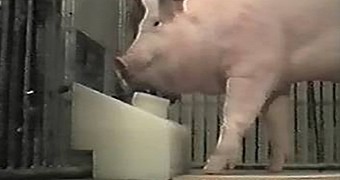Not trying to be mean or anything, but pigs have never been considered the sharpest knife in the drawer, so it’s pretty hard to imagine one actually playing a game.
And yet, a team of researchers from Purdue University actually tried to figure this out themselves, so they decided to show pigs how to play games and then hope they would eventually learn to do the whole thing on their own.
Using a pair of joysticks to control a version of Pong, four pigs have been trained to use their snouts to play the game, getting a reward every time they accomplished a simple task as responding to what was happening on the screen.
A clear learning curve
Of course, all they had to do was to move a cursor displayed on the screen to make contact with one, two, or three walled targets showing up at random places on the monitor. So theoretically, the pigs just had to move the cursor to collide with a target, in which case the game generated a sound and the pigs were given a reward.
“The video-task acquisition required conceptual understanding of the task, as well as skilled motor performance. Terminal performance revealed that all pigs were significantly above chance on first attempts to contact one-walled targets (p < 0.05). These results indicate that despite dexterity and visual constraints, pigs have the capacity to acquire a joystick-operated video-game task. Limitations in the joystick methodology suggest that future studies of the cognitive capacities of pigs and other domestic species may benefit from the use of touchscreens or other advanced computer-interfaced technology,” the researchers explained in a paper published in the Frontiers in Psychology.
The researchers believe there’s a learning curve for the pigs, so theoretically, they would be able to improve the way they play games over time.
But on the other hand, don’t expect them to eventually be able to play Call of Duty.
“It should be noted that despite performing above chance on the SIDE task, even the pig that performed best did not approach the level attained by non–human primates that acquired the task after a comparable number of trials,” the research reads.

 14 DAY TRIAL //
14 DAY TRIAL //